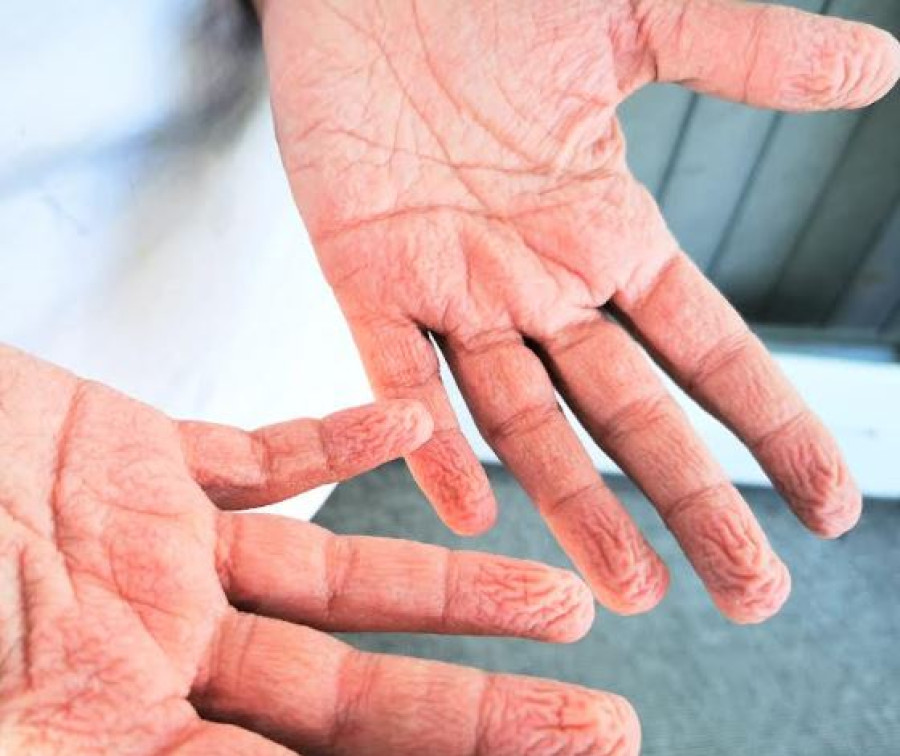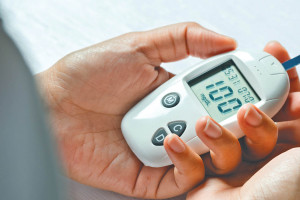Culture & Lifestyle
Why do our fingers wrinkle in water?
Dr Laila Lama Tangbeni discusses the causes, effects and management of pruney fingers.
Timila Maharjan
Dr Laila Lama Tangbetani, senior consultant dermatologist at the National Academy of Medical Sciences (NAMS), Bir Hospital, discusses the causes, implications, and management strategies for pruney fingers.
What are pruney fingers and what are their causes?
When we immerse our hands in water for a prolonged period, the tips of our fingers, and sometimes the fingers as a whole, develop wrinkles and creases. This condition is called pruney fingers. It gets its name from its wrinkled appearance, which resembles a prune (dried plum).
The most recent theory is that water penetrates the outer skin layer, causing the outermost cells to swell slightly. A sympathetic nervous system response also causes blood vessels in the skin to constrict. The combination of constricted blood vessels and swollen outer cells creates tension on the skin’s surface, leading to wrinkles.
Does it affect other parts of the body as well?
The wrinkling effect mainly occurs in the thickest layer of the skin. This layer is found on the inner surface of the hands and feet—the palms and the soles, due to their constant rubbing against rough surfaces. There are more keratin cells in the epidermis of the hands and feet (especially fingers and toes) than in the other parts of the body. Also, the skin in these areas is glabrous or non-hairy, lacking hair follicles, sebaceous glands, and erector pylori muscles. Therefore, the wrinkling effect is greater in the hands and feet, and bunching up of the skin is less so in other parts, so wrinkling does not happen there.
Does the skin structure of fingers contribute to this phenomenon?
The unique anatomical composition of glabrous skin contributes to wrinkle formation. It is characterised by a thick layer of stratum corneum and an increased number of eccrine sweat glands.
Glabrous skin wrinkles are mainly due to the passive oedema of the stratum corneum. Once water enters, the stratum corneum expands to create a larger skin surface area and accommodate this expansion of skin wrinkles, forming ridges and valleys. The other factors that govern wrinkling are eccrine ducts, intact sympathetic function, and the mechanical turgor of the dermal layer.

Does the type of water (saltwater, freshwater, chlorinated water) affect the degree of wrinkling?
Yes, the type of water and its temperature affect the degree of wrinkling.
Fingertip wrinkling is less pronounced in saltwater and takes longer than in freshwater. This is probably because the salt gradient between the skin and the surrounding environment is lower in salt water, so the salt imbalance that triggers the nerve fibres is less dramatic.
Skin wrinkles more rapidly in hypertonic solutions, such as chlorinated or soapy water, due to changes in the tonicity or pH of the immersed medium.
An increased temperature can facilitate more fluid diffusion into the skin. Research on the effect of varying temperatures to induce wrinkling concluded that water temperature has no significant impact on the degree of wrinkling. The water temperature did not alter the length of peaks and valleys in the skin. However, it did have a significant effect on how long it took to make them. So, wrinkling occurs sooner in warm water.
Can pruney fingers indicate underlying health conditions?
Pruney fingers are a normal physiological process, and they are generally harmless and go away on their own. However, extended pruning that doesn’t occur due to water can be a symptom of an underlying medical issue. Various medical conditions that may be related to pruney fingers are
Skin conditions such as hand eczema
Dehydration
Diabetes
Thyroid disorder
Connective tissue disorders such as lupus and scleroderma
Are there any specific skin diseases that can complicate the condition?
Yes. Generally, any skin disorder that causes dry skin, such as eczema or ichthyosis, can make pruney fingers more pronounced.
Does it damage the skin over time?
Frequent and prolonged immersion of hands in water may lead to skin dryness. This further damages the hand’s normal skin barrier, making it more prone to irritant and allergic contact dermatitis.
How to treat the condition?
Generally, pruney fingers do not require treatment. The fingers will return to normal shortly after coming out of the water. Applying moisturisers to your hands is recommended to ease some of the dryness.
In cases with an underlying cause, the treatment depends on the cause. Other health conditions that cause pruney fingers each need different treatments. These can include:
Treatment of eczema using steroid creams
Treating thyroid disease with thyroid hormone pills
Easing dehydration by drinking more water
Using compression bandages and exercise to treat lymphedema
Taking immune-suppressing medications for lupus or scleroderma




 19.12°C Kathmandu
19.12°C Kathmandu















